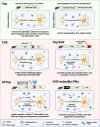Animal models to investigate the effects of inflammation on remyelination in multiple sclerosis
- PMID: 36407761
- PMCID: PMC9669474
- DOI: 10.3389/fnmol.2022.995477
Animal models to investigate the effects of inflammation on remyelination in multiple sclerosis
Abstract
Multiple sclerosis (MS) is a chronic inflammatory, demyelinating, and neurodegenerative disease of the central nervous system (CNS). In people with MS, impaired remyelination and axonal loss lead to debilitating long-term neurologic deficits. Current MS disease-modifying drugs mainly target peripheral immune cells and have demonstrated little efficacy for neuroprotection or promoting repair. To elucidate the pathological mechanisms and test therapeutic interventions, multiple animal models have been developed to recapitulate specific aspects of MS pathology, particularly the acute inflammatory stage. However, there are few animal models that facilitate the study of remyelination in the presence of inflammation, and none fully replicate the biology of chronic demyelination in MS. In this review, we describe the animal models that have provided insight into the mechanisms underlying demyelination, myelin repair, and potential therapeutic targets for remyelination. We highlight the limitations of studying remyelination in toxin-based demyelination models and discuss the combinatorial models that recapitulate the inflammatory microenvironment, which is now recognized to be a major inhibitor of remyelination mechanisms. These models may be useful in identifying novel therapeutics that promote CNS remyelination in inflammatory diseases such as MS.
Keywords: EAE; adoptive transfer; cuprizone; inflammation; multiple sclerosis; remyelination.
Copyright © 2022 Gharagozloo, Mace and Calabresi.
Conflict of interest statement
The authors declare that the research was conducted in the absence of any commercial or financial relationships that could be construed as a potential conflict of interest.
Figures

Similar articles
-
Transfer of myelin-reactive th17 cells impairs endogenous remyelination in the central nervous system of cuprizone-fed mice.J Neurosci. 2015 Jun 3;35(22):8626-39. doi: 10.1523/JNEUROSCI.3817-14.2015. J Neurosci. 2015. PMID: 26041928 Free PMC article.
-
Pre-clinical and Clinical Implications of "Inside-Out" vs. "Outside-In" Paradigms in Multiple Sclerosis Etiopathogenesis.Front Cell Neurosci. 2020 Oct 27;14:599717. doi: 10.3389/fncel.2020.599717. eCollection 2020. Front Cell Neurosci. 2020. PMID: 33192332 Free PMC article. Review.
-
Dendrosomal nanocurcumin promotes remyelination through induction of oligodendrogenesis in experimental demyelination animal model.J Tissue Eng Regen Med. 2020 Oct;14(10):1449-1464. doi: 10.1002/term.3110. Epub 2020 Aug 18. J Tissue Eng Regen Med. 2020. PMID: 32750189
-
Remyelination Pharmacotherapy Investigations Highlight Diverse Mechanisms Underlying Multiple Sclerosis Progression.ACS Pharmacol Transl Sci. 2019 Nov 14;2(6):372-386. doi: 10.1021/acsptsci.9b00068. eCollection 2019 Dec 13. ACS Pharmacol Transl Sci. 2019. PMID: 32259071 Free PMC article. Review.
-
Brain region dependent molecular signatures and myelin repair following chronic demyelination.Front Cell Neurosci. 2023 Apr 26;17:1169786. doi: 10.3389/fncel.2023.1169786. eCollection 2023. Front Cell Neurosci. 2023. PMID: 37180951 Free PMC article.
Cited by
-
Microbiota-Driven Mechanisms in Multiple Sclerosis: Pathogenesis, Therapeutic Strategies, and Biomarker Potential.Biology (Basel). 2025 Apr 17;14(4):435. doi: 10.3390/biology14040435. Biology (Basel). 2025. PMID: 40282300 Free PMC article. Review.
-
Mitochondrial dysfunction, iron accumulation, lipid peroxidation, and inflammasome activation in cellular models derived from patients with multiple sclerosis.Aging (Albany NY). 2025 Feb 6;17(2):365-392. doi: 10.18632/aging.206198. Epub 2025 Feb 6. Aging (Albany NY). 2025. PMID: 39918890 Free PMC article.
-
Neuroprotective effects of ghrelin in cuprizone-induced rat model of multiple sclerosis.Metab Brain Dis. 2025 Apr 11;40(4):176. doi: 10.1007/s11011-025-01603-z. Metab Brain Dis. 2025. PMID: 40214860 Free PMC article.
-
Meningeal lymphatic function promotes oligodendrocyte survival and brain myelination.Immunity. 2024 Oct 8;57(10):2328-2343.e8. doi: 10.1016/j.immuni.2024.08.004. Epub 2024 Aug 31. Immunity. 2024. PMID: 39217987
-
Fasudil-modified macrophages reduce inflammation and regulate the immune response in experimental autoimmune encephalomyelitis.Neural Regen Res. 2024 Mar;19(3):671-679. doi: 10.4103/1673-5374.379050. Neural Regen Res. 2024. PMID: 37721300 Free PMC article.
References
Publication types
Grants and funding
LinkOut - more resources
Full Text Sources

